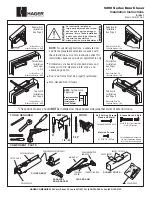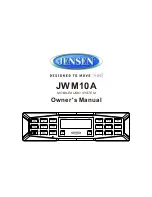
12
CIRCULATING AIR AND FILTERS
Airflow Conversion
Units can easily be converted from horizontal to down-dis-
charge airflow delivery. In down-discharge or high static in
-
stallations, the installer should measure the total external
static and review the blower performance charts before per-
forming the installation. In some installations it will be neces-
sary to change the blower speed to provide proper air flow.
Horizontal Air Flow
Single phase models are shipped without horizontal duct
covers. If needed, these kits may be ordered through Good
-
man’s Service Parts department.
Down Discharge Applications
Cut insulation around bottom openings and remove panels
from the bottom of the unit, saving the screws holding the
panels in place.
NOTE:
Single phase models require installation of hori-
zontal duct kit #20464501PDGK (medium chassis) and
#20464502PDGK (large chassis). See “Unit Dimensions”
section for chassis sizes.
Duct Cover Installation
Ductwork
Duct systems and register sizes must be properly designed
for the C.F.M. and external static pressure rating of the unit.
Ductwork should be designed in accordance with the recom-
mended methods of Air Conditioning Contractors of Ameri-
ca Manual D (Residential) or Manual Q (Commercial). All
ductwork exposed to the outdoors must include a weather-
proof barrier and adequate insulation.
A duct system should be installed in accordance with Stan-
dards of the National Board of Fire Underwriters for the In-
stallation of Air Conditioning, Warm Air Heating and Ventilat
-
ing Systems. Pamphlets No. 90A and 90B.
The supply duct from the unit through a wall may be installed
without clearance. However, minimum unit clearances as
shown in the appendix must be maintained. The supply duct
should be provided with an access panel large enough to
inspect the air chamber downstream of the heat exchanger.
A cover should be tightly attached to prevent air leaks.
For duct flange dimensions on the unit refer to the Unit Di
-
mension illustration in the appendix.
For down-discharge applications, the ductwork should be at-
tached to the roof curb prior to installing the unit. Ductwork
dimensions are shown in the roof curb installation manual.
If desired, supply and return duct connections to the unit
may be made with flexible connections to reduce possible
unit operating sound transmission.
Filters
CAUTION
To prevent property damage due to fire and loss of
equipment efficiency or equipment damage due to dust and
lint build-up on internal parts, never operate the unit
without an air filter installed in the return air system.
Even though a return air filter is not supplied with this unit,
there must be a means of filtering all return air. All units may
be externally filtered.
Refer to the unit filter size chart in the appendix for filter size
information.
Filters installed external to the unit should be sized in accor-
dance with their manufacturer recommendations. A throw-
away filter must be sized for a maximum face velocity of 300
feet per minute.
Filter Installation
IMPORTANT NOTE:
When installing a filter, the air flow ar
-
rows on the filter must point toward the circulator blower.
VENTING
NOTE: Venting is self-contained. Do not modify or block.
Installation - Flue Hood Exhaust
1. Locate the flue hood assembly box in the unit.
2. Slide screen over flanges on the lower flue hood.
3. Slide screen and lower flue hood into hood.
4. Using the three screws provided, attach the hood
(with the opening facing down) over the flue exhaust
opening in the utility panel.
SCREEN
HOOD
LOWER
FLUE
HOOD
LIP
Installation - Combustion Air Intake Hood
1. Locate the second hood.
Содержание APG 16 M Series
Страница 28: ...28 CFM OUTPUT AND DIP SWITCH SETTINGS...
Страница 31: ...31 THIS PAGE IS LEFT INTENTIONALLY BLANK...













































